
Photo credit: artonthefilm on Pexels
In this activity, we will measure carbon stocks and greenhouse gas (GHG) fluxes and quantify biodiversity indicators in urban wetlands and stormwater ponds, to be used in the RISE Scorecard.
In urban developments, most wetlands are stormwater ponds and tend to show higher nutrient concentrations, therefore acting as a GHG source. Conversely, stormwater wetlands store more carbon than ponds, suggesting that changes to the design of stormwater infrastructure may enhance carbon storage and reduce GHG emissions in urban residential developments. Further, conservation of natural wetlands and better design of constructed wetlands within residential developments will also provide co-benefits such as biodiversity protection and flood mitigation.
We will measure GHG fluxes from urban wetlands and compare them to natural wetlands in the region, and link to the hydrological modelling from Activity 4 and Activity 5. We will investigate how much carbon is stored in soils and sediment in urban wetlands, and investigate how aquatic GHG fluxes are related to catchment characteristics and wetland conditions. Further, we will divide the carbon sequestration in wetlands and stormwater management infrastructure among key aquatic organisms in order to further understand primary carbon production, rates of production, and variations across stormwater system designs and hydrology. Finally, we will quantify the habitat value and biodiversity of wetlands and stormwater ponds to understand the biodiversity using these aquatic systems, and how the biodiversity varies with the ecohydrology and surrounding land use. We will further develop a model to predict the susceptibility of these systems to invasive plants in order to understand how the biodiversity relates to plant invasions and determine how to predict the habitat value and resistance to invasive plants of these water bodies.